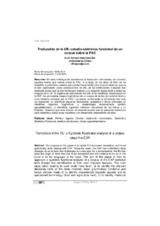Mostrar el registro sencillo del ítem
Traducción en la UE: estudio sistémico funcional de un corpus sobre la PAC
| dc.contributor.author | Veroz González, María Azahara | |
| dc.date.accessioned | 2018-02-09T11:56:32Z | |
| dc.date.available | 2018-02-09T11:56:32Z | |
| dc.date.issued | 2013 | |
| dc.identifier.issn | 2255-3703 | |
| dc.identifier.uri | http://hdl.handle.net/10396/16122 | |
| dc.description.abstract | En esta investigación abordamos la traducción comunitaria, en concreto aquellos textos que versen sobre la PAC. A lo largo de los años, la PAC se ha sometido a profundos cambios para poder hacer frente a los nuevos desafíos que se le iban planteando; como consecuencia de ello, de las instituciones europeas han emanado textos que se han tenido que traducir y se seguirán traduciendo a todas las lenguas de la UE. El objetivo de este estudio ha sido el de identificar, basándonos en la GSF, los principales rasgos lingüísticos de un corpus de textos de carácter técnico cuya temática principal sea la PAC. Los pasos conducentes a tal estudio han sido los siguientes: a) identificar aspectos discursivos: gramática y léxico utilizados; b) identificar aspectos lingüísticos y terminología especializada (ámbito agroalimentario), c) identificar aspectos retóricos: naturaleza de los textos y su finalidad. Creemos que esta división es esencial puesto que la operación traductora está sometida a todas estas variables y es claramente dependiente de ellas. | es_ES |
| dc.description.abstract | Our purpose in this paper is to tackle EU document translation, and more specifically, texts dealing with CAP. Along the years, the CAP has undertaken deep changes so as to face new challenges in a new age. As a consequence, the EU has been the origin of texts that had to be translated and will continue to be so in the future in all the languages of the Union. The aim of this paper is then to approach a systemic functional analysis of a Corpus of the CAP technical texts through the identification of their main linguistic features. The main steps taken leading to such study have been: a) to identify the relevant discourse traits of the texts involved: basic grammatical functional and lexical choices made; b) to identify characteristic linguistic aspects and its specialized terminology (food and agriculture field); c) to identify rhetorical aspects: texts genre and their communicative scope and use. We believe the whole process of analysis is necessary, since translation has to undertake all the variations expressed above and it is supposed to be crucially determined by them. | es_ES |
| dc.format.mimetype | application/pdf | es_ES |
| dc.language.iso | spa | es_ES |
| dc.publisher | UCOPress | es_ES |
| dc.rights | https://creativecommons.org/licenses/by/3.0/ | es_ES |
| dc.source | Skopos 2, 187-210 (2013) | es_ES |
| dc.subject | Política Agraria Común | es_ES |
| dc.subject | Traducción comunitaria | es_ES |
| dc.subject | Gramática Sistémico Funcional | es_ES |
| dc.subject | Análisis del discurso | es_ES |
| dc.subject | Textos agroalimentarios | es_ES |
| dc.subject | Common Agricultural Policy | es_ES |
| dc.subject | EU document translation | es_ES |
| dc.subject | Systemic Functional Grammar | es_ES |
| dc.subject | Discourse analysis | es_ES |
| dc.subject | Agro-alimentary texts | es_ES |
| dc.title | Traducción en la UE: estudio sistémico funcional de un corpus sobre la PAC | es_ES |
| dc.title.alternative | Translation in the EU: a Systemic Functional analysis of a corpus about the CAP | en |
| dc.type | info:eu-repo/semantics/article | es_ES |
| dc.relation.publisherversion | https://www.uco.es/ucopress/ojs/index.php/skopos/index | es_ES |
| dc.rights.accessRights | info:eu-repo/semantics/openAccess | es_ES |

